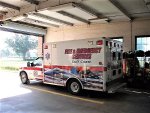*sigh* how did I make the awd/4wd mistake, it was a long week :coffeedrink:
Very interesting that 2wd type ones are chosen. I've talked with a coworker who is a volunteer in a rural area of Alberta and he was mentioning the driver for the type I was picked by areas more rural. Then again we are in Alberta so snow is likely a much bigger deciding factor that areas which might have a temperate climate, and only need 4wd if they are actually expected to go off road. Alberta and BC health service seem to favour type iii's, yet Saskatchewan seems to have an abundance of type ii's
6 hours and counting, will update this post soon.
Update: I'm curious to hear everyone's take on this thing, it has 237k Km's (150k miles), and low hours. This makes me suspect it was mostly highway miles, as the other I've been looking at has 100k miles, but 5000 hours of service. This is an alberta rig, so minor frame rust is not surprising, and the airbag support in the rear is a nice feature.
Anyways, pics!













